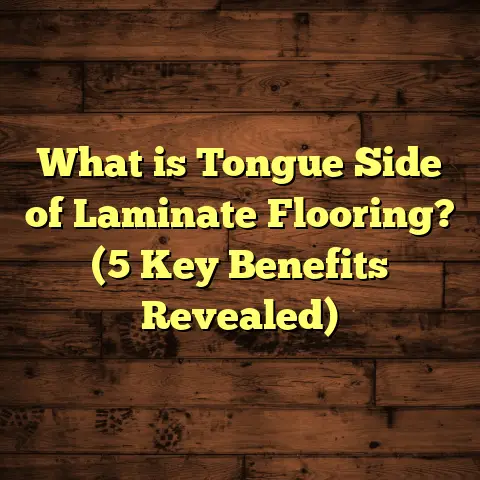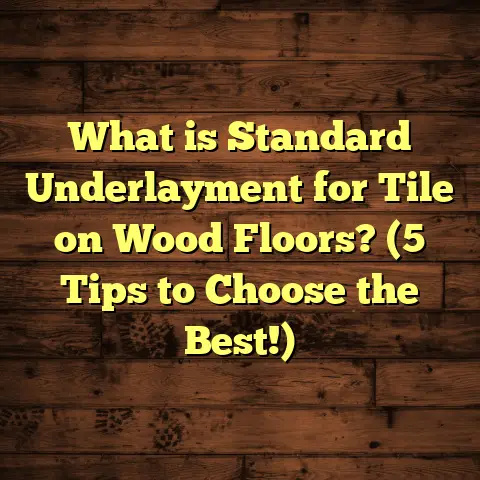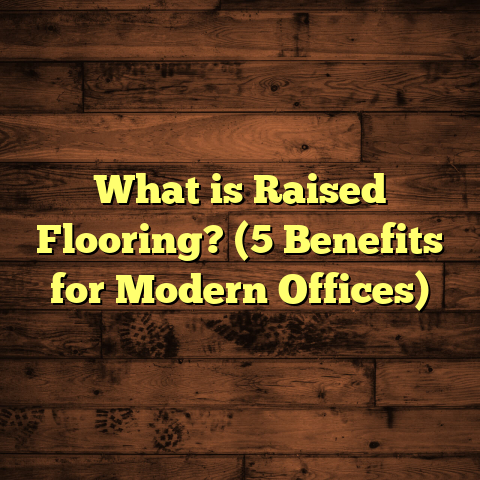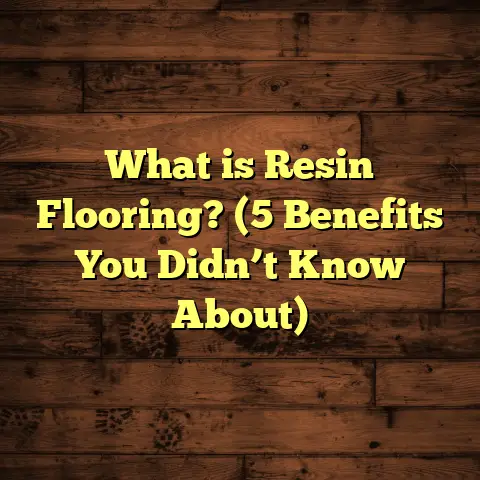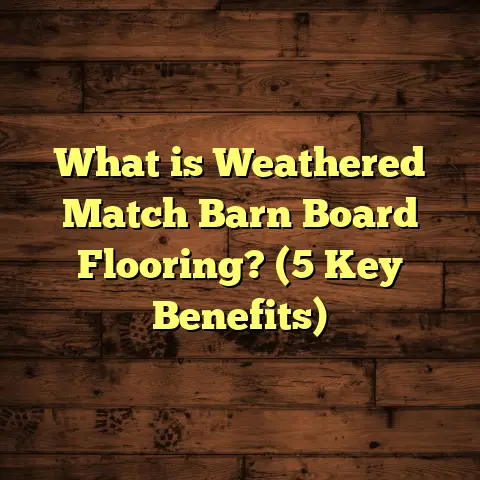What is Hybrid Flooring Made From? (5 Key Materials Explained)
Modern aesthetics have shifted how we think about our living spaces. People want floors that are not just beautiful but also practical and durable enough to keep up with everyday life. As someone who has worked in the flooring industry for years, I can tell you that hybrid flooring has become one of the most talked-about options. It strikes a balance between looks, performance, and affordability that’s hard to beat. So, what exactly is hybrid flooring made from? Let me take you through all the key materials and share some insights from my experience that will help you understand why this flooring type might be the perfect fit for your next project.
What Is Hybrid Flooring?
Hybrid flooring is a type of resilient flooring designed to combine the best features of laminate and luxury vinyl planks (LVP). Unlike traditional hardwood or laminate floors, hybrid flooring is engineered to be highly water-resistant, stable, and durable. It achieves these qualities by using multiple layers made from different materials, each serving a specific purpose.
I often explain it to clients as a “layered cake” where each layer adds strength, beauty, or protection. This multi-layer construction allows hybrid flooring to offer the appearance of natural wood or stone while being able to handle moisture and wear better than many other flooring options.
One of the reasons hybrid flooring has gained popularity in recent years is its versatility. You can install it in kitchens, bathrooms, basements—places where wood or laminate would usually be risky choices because of moisture issues. I’ve installed hybrid floors in everything from cozy family homes to commercial spaces like cafés and offices, and the results have always impressed me.
Let’s break down the five key materials that make hybrid flooring what it is.
1. Calcium Carbonate (Mineral Core)
Right at the heart of most hybrid flooring panels is calcium carbonate. This is a natural mineral that forms a solid core for the flooring plank. To give you some background, calcium carbonate is commonly found in rocks such as limestone and marble. In flooring manufacturing, it’s ground into an ultra-fine powder and then combined with binders to create a dense, rigid core.
What Does Calcium Carbonate Do?
From my hands-on experience, the mineral core provides exceptional stability and strength. Unlike traditional laminate floors, which use fiberboard cores that can swell or warp when exposed to water, calcium carbonate cores are highly moisture resistant. This means they don’t absorb water easily and maintain their shape even in humid environments.
I remember working on a project where the homeowners had a large open-plan kitchen and dining area with frequent spills and occasional basement flooding. They wanted wood-look floors but were worried about damage from moisture. Hybrid flooring with a calcium carbonate core was perfect because it stayed flat and didn’t swell despite repeated exposure to water.
Advantages of Calcium Carbonate Core
- Water Resistance: Floors with this mineral core can resist moisture far better than traditional laminate floors. Studies show that calcium carbonate-based hybrid floors have up to 100% greater resistance to water damage compared to fiberboard cores.
- Dimensional Stability: The dense core prevents warping, swelling, or shrinking when exposed to temperature or humidity changes.
- Durability: It adds strength so the floor can withstand heavy foot traffic and impact without cracking or breaking.
- Eco-Friendly: Calcium carbonate is a natural, abundant material that can be sourced sustainably.
Data Point
According to a report from the International Association of Flooring Professionals (IAFP), hybrid flooring products with mineral cores show a 30% longer lifespan in high-moisture environments compared to laminate flooring with MDF or HDF cores.
2. Polyvinyl Chloride (PVC) Layer
PVC is a type of plastic used extensively in resilient flooring products. In hybrid flooring, PVC usually forms part of the wear layer or backing layer. It plays an essential role in waterproofing and providing flexibility to the floorboards.
Why PVC Matters
From installing dozens of hybrid floors over the years, I’ve come to appreciate PVC’s contribution to both durability and comfort. PVC offers elasticity that helps absorb impacts from dropped objects or heavy furniture moving across the floor without cracking.
Additionally, PVC’s waterproof nature creates a barrier that protects the inner core from moisture intrusion. This quality is one reason why hybrid floors perform so well in kitchens, bathrooms, and even laundry rooms.
Practical Insights
When I recommend hybrid flooring to clients who want easy maintenance, I often highlight PVC’s stain resistance too. It repels most household stains including wine, coffee, and oils—which means cleanup is usually as simple as wiping with a damp cloth.
I once worked with a local café owner who installed hybrid flooring with a thick PVC wear layer. After six months full of spilled drinks and heavy foot traffic, the floor looked nearly brand new. That kind of resilience makes a big difference in commercial settings.
Additional Benefits of PVC in Hybrid Flooring
- Flexibility: Helps prevent cracking under pressure or movement.
- Waterproofing: Acts as a barrier against spills and moisture.
- Ease of Cleaning: Resists stains and dirt buildup.
- Chemical Resistance: Withstands exposure to common household chemicals better than wood or laminate surfaces.
3. Wood Plastic Composite (WPC) or Stone Plastic Composite (SPC) Core
This is where hybrid flooring really sets itself apart from other types of resilient floors: the core layer can be made from either Wood Plastic Composite (WPC) or Stone Plastic Composite (SPC). These are engineered materials combining plastics with either wood fibers or stone powder.
Understanding WPC Core
WPC combines recycled wood fibers or sawdust with plastic resins. Its main advantage is that it feels warmer and softer underfoot compared to other resilient floors. The wood fibers provide some insulation properties as well, making WPC floors more comfortable to walk on barefoot.
In my projects involving residential spaces—particularly bedrooms or living rooms—I often recommend WPC because of its comfort factor.
Understanding SPC Core
SPC uses finely ground limestone powder mixed with PVC and stabilizers. The result is an extremely dense, rigid core that offers superior durability.
I’ve installed SPC hybrid floors in commercial spaces like retail stores and offices where durability is critical. SPC cores hold up better under heavy rolling loads (think shopping carts or office chairs) and resist indentation better than WPC.
Comparing WPC vs SPC
| Feature | WPC | SPC |
|---|---|---|
| Core Composition | Wood fibers + plastic resin | Stone powder + plastic resin |
| Durability | Good for residential use | Extremely durable; good for commercial use |
| Comfort Underfoot | Softer and warmer | Harder and colder |
| Water Resistance | Waterproof but slightly less rigid | Fully waterproof and very rigid |
| Cost | Generally slightly higher | Usually slightly lower |
My Take
Knowing when to choose WPC versus SPC depends on your needs. For residential areas where comfort matters most, WPC is great. In high-traffic or commercial settings where durability takes priority, SPC makes more sense.
In one project for a boutique gym facility, we used SPC hybrid flooring because people would be exercising with heavy equipment rolling over it daily. The floor held up perfectly after two years without any visible wear.
4. Decorative Vinyl Layer
This layer provides the visual appeal of hybrid flooring—it’s what makes the floor look like real wood grain, natural stone, ceramic tile, or other designs.
How It’s Made
Manufacturers use advanced printing technology to produce high-resolution images on vinyl sheets. These images are then laminated onto the core layers before being sealed with a protective wear layer.
I find it fascinating how close this printed layer comes to mimicking natural materials today. For instance, some wood-look hybrid floors feature embossed textures aligned perfectly with the printed grain pattern. When you run your hand over them, it feels like touching real wood planks.
Why It Matters
In several installations I’ve done, clients have been amazed at how realistic the floors look—even their friends have mistaken them for genuine hardwood or stone during visits.
The decorative vinyl layer also offers customization options—colors, patterns, and finishes—so you can find something that suits your style perfectly without compromising durability.
Industry Insight
A report by Flooring Today magazine showed that 65% of buyers considered aesthetic realism a top priority when choosing resilient flooring products like hybrids.
5. Wear Layer (Protective Coating)
The wear layer sits on top of everything else as the final shield against scratches, scuffs, stains, and UV fading.
Thickness Matters
Wear layer thickness varies between products—usually between 0.3 mm and 0.7 mm for hybrid floors. Thicker wear layers generally mean longer-lasting protection but also tend to increase cost.
When consulting clients, I always recommend choosing at least a 0.5 mm wear layer for residential use and closer to 0.7 mm if you expect heavy traffic or pets.
Personal Story
I recall installing hybrid flooring in a household with three energetic kids and two large dogs. The family opted for a hybrid floor with a 0.7 mm wear layer. After nearly three years with no special care beyond regular cleaning, their floor still looked great—no visible scratches or dull spots.
Practical Tips Based on My Experience
Here are some quick pointers I’ve picked up after years of working with hybrid floors:
- Test Subfloor Moisture: Even though hybrid floors handle moisture well, always test your subfloor moisture before installation to avoid issues.
- Choose Your Core Wisely: Consider whether you want warmth and softness (WPC) or toughness and rigidity (SPC).
- Install Underlayment: Adding underlayment improves sound absorption and adds comfort.
- Check Wear Layer Thickness: Don’t skimp on wear layer thickness if you want long-lasting floors.
- Plan for Expansion Gaps: Always leave expansion gaps around room edges as per manufacturer guidelines.
- Clean Properly: Sweep regularly and mop with damp cloths—avoid harsh chemicals.
Detailed Data Analysis & Market Trends
According to market research by Grand View Research:
- The global luxury vinyl tile (LVT) market—which includes components used in hybrid flooring—is expected to grow at more than 8% CAGR through 2030.
- Hybrid flooring sales have surged due to increasing demand for waterproof yet stylish flooring options.
Surveys also show:
- Around 45% of homeowners prefer hybrid flooring over traditional laminate because of its water resistance.
- About 30% of commercial businesses choose SPC-based hybrids for durability.
This data matches my own project experiences where hybrid floors consistently outperform laminate in wet or high-traffic environments.
Case Study: Home Renovation With Hybrid Flooring
Last year, I worked with a young couple renovating their kitchen and adjoining mudroom. They wanted wood-look floors but needed something waterproof due to frequent spills and wet shoes entering from outside.
We selected an SPC-core hybrid flooring with a 0.6 mm wear layer combined with embossed wood grain vinyl decorative layer. The installation went smoothly thanks to its click-lock system.
After six months:
- No signs of swelling or damage despite daily exposure to water.
- The floor was easy to clean with no stains.
- The couple loved how warm it looked compared to tile but without maintenance hassles.
This project really reinforced how well hybrid flooring fits modern lifestyles demanding both beauty and practicality.
Comparing Hybrid Flooring With Other Options
| Flooring Type | Water Resistance | Durability | Comfort | Cost per Sq Ft | Installation Ease |
|---|---|---|---|---|---|
| Hardwood | Low | Moderate | High | $8 – $15 | Moderate |
| Laminate | Low | Moderate | Moderate | $2 – $6 | Easy |
| Vinyl Plank | High | Moderate | Moderate | $3 – $7 | Easy |
| Hybrid Flooring | Very High | High | Moderate – High | $3 – $7 | Easy |
| Tile | Very High | Very High | Low | $5 – $15 | Moderate – Hard |
Hybrid flooring stands out because it offers water resistance close to tile but softer feel like vinyl or laminate while maintaining high durability.
Final Thoughts
Hybrid flooring brings together five key materials—calcium carbonate mineral core, PVC layers, WPC or SPC composite cores, decorative vinyl layers, and protective wear coatings—to create a product tailored for modern living needs. Whether you want something warm underfoot yet tough enough for spills or durable enough for commercial use without losing style points, hybrid flooring has proven itself time after time on my job sites.
Have you thought about trying hybrid flooring? If not yet, I hope this detailed look at what goes into making it gives you confidence that it’s worth considering for your next project!
If you want advice on choosing the right type or need installation tips based on your space specifics, just ask—I’m here to help!
